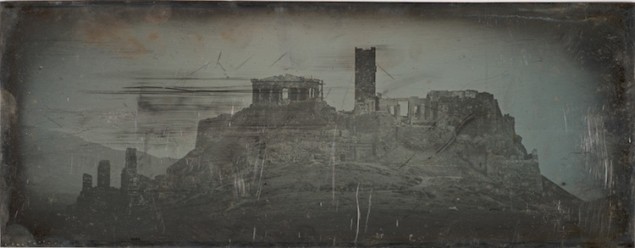
The optical properties of daguerreotypes, the earliest types of photographs, invented in the nineteenth century, come from the plasmonic response of the metallic nanostructures on their surface. This new finding, from researchers at the University of New Mexico (UNM) and the Metropolitan Museum of Art (The Met) in New York will not only be important for developing protocols for preserving these valuable works of art, but also for inventing new plasmonic colour printing technologies in the future.
Plasmons are the collective oscillations of electrons on the surface of metallic nanostructures that interact very strongly with light and produce vivid colours. They could thus be used for developing new colour printing technologies for use in applications such as sensing, imaging, actuation and displays.
The light-matter interaction is strongest at the plasmon-resonance frequency, which is defined by the size and shape of nanoparticles and their charge density. This frequency dictates which light frequencies the nanostructure absorbs and scatters when light is shone on it.
From art to science
Researchers in plasmonics have been manipulating the characteristics of metallic nanostructures for the last ten years or so now to be able to control their light-scattering properties. “However, before plasmonic nanostructures became a science, they were an art,” explains Alejandro Manjavacas of the Department of Physics and Astronomy at the UNM, who co-led this research effort with Silvia Centeno of the Department of Scientific Research at The Met. “Indeed, daguerreotypes owe their incredible properties, image resolution and dynamic range to light scattering to surface plasmons. Plasmons are also responsible for the colour in some stained-glass windows and pottery.”
For centuries, people searched for increasingly better ways to capture an image, he says. Images projected by a camera obscura, for example, were first used as guides for drawing and painting natural scenery and portraits from the seventeenth century onwards, but these images could not be permanently captured. Early photographers understood that permanent image capture would require light-matter interactions and identified suitable photoreactive materials, such as silver halides, that might be used to do this. The rest is history.
Daguerreotypy was the first commercially successful technology to make use of the light sensitivity of silver halides. It was invented by the French painter Louis-Jacques-Mandé Daguerre (1787-1851) and the technique was able to capture an image from a camera with extraordinary resolution and clarity – that rival even the high-resolution images possible today.
Light scattering by metallic nanoparticles creates an image
Daguerreotypy is different to other types of photography in that it relies on light scattering by metallic nanoparticles to create an image that projects off a silver substrate, explains Manjavacas. The balance between the light scattered by the nanostructures and the specular reflection of the substrate creates bright and dark tones respectively. Tones in between these depend on the density of the nanostructures. What is more – and this is something that is unique to daguerreotypes – the image tones can change with viewing angle, and it is because of this property that they can be considered as the first realization of plasmonic colour printing.
In their new work, Manjavacas and colleagues analysed the morphology and material characteristics of the nanoparticles on the surface of several daguerreotypes from the study collection at The Met as well as modern plates made by Century Darkroom in Toronto to recreate effects seen in historical plates. They then used the information they obtained to model the response of an “average” nanostructure using a Maxwell’s equation numerical solver.
“The results of this modelling allow us to explain optical effects that were empirically known but never explained from a scientific perspective until now,” says Manjavacas. “For example: the change of colour of the image as we vary the viewing angle; the intense and tuneable colour tone achieved though ‘solarisation’ and other exposure techniques used during daguerreotypy; and the warmer hue provided to the daguerreotype image by gilding – which involves adding a nanoscale layer of gold to it.”
Two primary resonances
The researchers discovered that the light scattering spectrum of individual nanoparticles on the daguerreotypes consists of a narrow blue/ultra-violet peak (at around 365 nm) and a broader red peak (at around 670 nm). “The nanostructures in fact support two primary resonances: a transversal dipole mode on the blue side of the spectrum and a vertical dipole mode on the red side,” Manjavacas tells Physics World. “The first mode radiates predominantly in the vertical direction, so the daguerreotype exhibits a blue tone when viewed from above, while the second mode radiates at large angles. This means that the tone shifts to red as the viewing angle increases.”

The power of images
And that is not all; the UNM-Met team also found that the scattering spectrum strongly depends on the particle shape and size but not on its composition. Indeed, decreasing the height of a nanoparticle creates a blueshift in the spectrum while increasing overall nanoparticle size causes a redshift and a broadening of the spectral peak (so reducing the viewing angle-dependent colour-change effect).
“Our results provide invaluable insights for how to protect these valuable works of art, which are irreplaceable records of history and culture that must be preserved for posterity,” says Manjavacas. “They could also inspire new approaches for plasmonic colour printing in the future.”
The researchers, reporting their work in PNAS 10.1073/pnas.1904331116, say they will now use the knowledge they have gained in this study to understand some of the degradation processes that daguerreotypes suffer.



